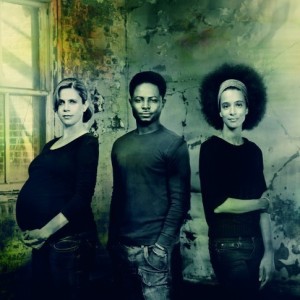When I reviewed Canadian choreographer Dave St-Pierre’s Un Peu de Tendresse Bordel de Merde! on its Sadler’s Wells debut back in June last year, I described it as “not a show for the faint-hearted (nor for the flob-averse).” There seems little point in denying that the show contains two dozen naked Canadians, who at various points descend into the audience for some eye-socking full-frontal encounters.Portions of the work are decidedly biological, and anyone uncomfortable with dangly bits in their close proximity is unlikely to be comfortable with this show. There’s also plenty of hearty Gallic expectoration. But none of this stops Un Peu de Tendresse… being by turns hilarious, affecting and beautiful.
Critics at the London performances were sharply divided on the show’s merits. A few declared the show’s (literally) in-your-face
nudity offensive; the Daily Mail’s Quentin Letts went so far as to call it “an assault on our values.” It’s hard to imagine many people in the 21st century still being offended by the sight of the human body, and it must be said that the use of nudity in this production is neither gratuitous nor titillating: St-Pierre’s naked characters are played as innocent ingénues, skipping gaily about the stage with the kind of free abandon that most of us have long since left behind.
Other detractors labelled the piece’s perceived shock-tactics tedious or hackneyed, pointing to shows (Hair and Oh! Calcutta among them) that displayed their performers at a time when nudity onstage was uncommon. For me, this objection also misses the essence of the production – the nudity is not designed to shock in the sense of senseless provocation, but rather to reveal the dancers in all their human vulnerability. Dancers appear not merely naked, but dressed in blonde milkmaid wigs that effect a total transformation of character from taciturn adults to pleasureseeking infants.
Many of St-Pierre’s nude scenes are uproariously funny, the blonde-wigged male characters flocking together to comment on the action in squeaky falsetto voices. Other sequences delve – often poignantly – into the tenderness of the title. A slapstick scene in which a bewigged gentleman tries repeatedly to take a running jump into the arms of his suitor ends in distressing failure; his raw nakedness leaves no hiding place for fear of rejection, fear of intimacy or simple fear.
One or two critics of the London show disliked being singled out by dancers in the scene where the performers romp among the audience, not so much breaking the fourth wall as smashing right through it in a move that completely removes the line between performer and audience. This was probably the scene that enjoyed the most walkouts, but is also absolutely key to the performance as a whole. By participating in this baptism of flesh, the audience identifies much more readily with the performers for
the rest of the show (critic Sanjoy Roy described this as feeling “tenderised” by the sequence).
Survive this scene and you’ll receive frosty congratulations from “Sabrina”, our sardonic onstage narrator. Sabrina comments on the frantic attempts at coupling around her with icy detachment; at times, she seems to function as a superdominant superego, demanding that we repress all pleasures into the bottoms of our psyches. Clothed, the performers submit to Sabrina’s will: gruff and stoic, the men silently rebuff their female partners and the women can do little to connect with them. Naked, the performers openly seek affection, attention and love like the giddy inner children they portray.
St-Pierre’s work is clearly indebted to the late, great Pina Bausch and her emotionally exposing Tanztheater; indeed, Bausch herself blessed St-Pierre’s dancers as “my illegitimate, pornographic children.” Illegitimate they may be, but I’d dispute the charge of pornography – Un Peu de Tendresse… is finally not a work about bodies or sex, but about human frailty, vulnerability and (the clue’s in the title) tenderness. Bring an open mind, a sense of humour – and if you’re in the first few rows, some kind of spit-protection.
Lise Smith is a dance artist and writer, regularly contributing to londondance.com and a number of other arts publications.
Dave St Pierre Company // Un peu de tendresse bordel de merde!
26-28 April //Warwick Arts Centre, Coventry
idfb.co.uk/tenderness

